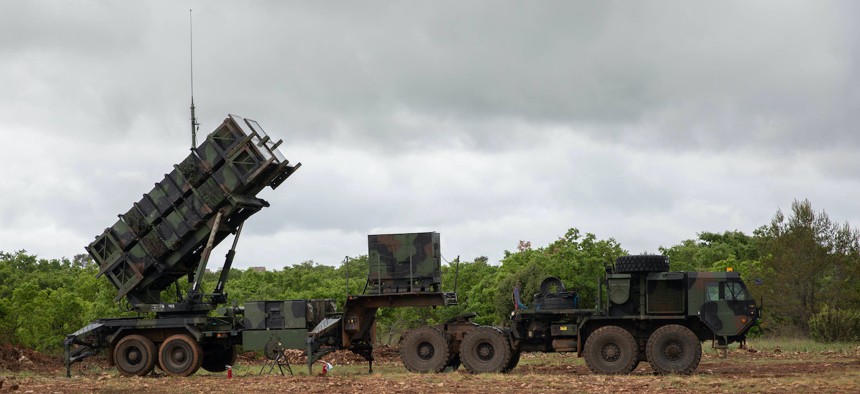
The 5th Battalion, 7th Air Defense Artillery’s U.S. Army Patriot Missile Systems arrived in Croatia May 17, 2021 to participate in DEFENDER-Europe 21 associated exercise Astral Knight 21 and exercise Immediate Response 21. U.S. Army / Sgt. Alexandra Shea
Army Focuses on China and Ukraine-Related Ammo Production in 2024 Budget
Army wants more spending on hypersonic weapons and plans large buys of anti-aircraft weapons as it gears up to counter China.
The U.S. Army is requesting $185.5 billion in its 2024 budget, with spending focused on countering China and improving the defense industrial base amid the ammunition-hungry Ukraine war.
The “challenge is in the Indo-Pacific region,” Army Under Secretary Gabe Camarillo said Monday.
The Army budget calls for large increases in research spending and missile inventories, which Defense Secretary Lloyd Austin said are key to countering China. The Army’s total proposed spending on missiles clocks in at $4.9 billion, up from $3.8 billion last year.
At the top of the Army’s wish list is $944 million in research and development for the Long-Range Hypersonic Weapon missile, and $380 million in research and development for the Mid-Range Capability missile. The Army also wants $384 million to manufacture Precision Strike Missiles.
The service also wants to spend big on missile and anti-aircraft defense to deter China. The biggest ticket item is Patriot missiles, with a proposed budget of $1.2 billion, versus last year's $1 billion proposal.
Additionally, the Army is asking for more funding for M-SHORAD short range anti-air missiles, raising its request from $136 million last year to $401 million this year. The service’s stock of older Stinger missiles is low because they sent them to Ukraine to defend against Russia, Army leaders have said.
The Army is also budgeting for air-defense lasers, including $111 million for a 50kW weapon for the Stryker vehicle and $86 million for a 300kW weapon to defend bases.
The service is also upping investments in logistics and alliances in the Pacific to deter China. The Army’s proposed contribution to the Department of Defense’s Pacific Deterrence Initiative is $1.5 billion, with $171 million for logistics and $43 million for cooperation with allies.
Ukraine is mostly absent from the Army’s budget documents. However, the service is proposing improving the network of 23 sites that store and manufacture some of the nation’s weapons and ammunition, as part of a re-thinking of U.S. munition requirements in light of the Ukraine war
The 2024 budget proposal includes a total of $1.5 billion in spending, with the largest chunk of that total going to the “provision of industrial facilities” at $729 million. That could refer to facility modernization, expansion, or construction, among other possibilities.
The defense industrial base investments are a “significant” increase over last year, Douglas Bush, assistant secretary of the Army for Acquisition, Logistics, and Technology, said March 10, but the service’s budget highlights document did not include a number for that investment.
And the spending is not focused solely on responding to Ukraine, Bush added, saying it was “good for all contingencies.”
The Army’s budget proposal also calls for investments in weapons systems that were provided to Ukraine. The Army envisions spending $866 million on 5,016 Guided Multiple Launch Rocket Systems after sending its stocks to Ukraine. The Army also hopes to spend $221 million on 155mm shells, which Ukraine is using in large quantities.
Production is constrained by manufacturers’ facilities, said Army Under Secretary Gabe Camarillo.
Responding to questions on the production of Javelin anti-tank missiles, which rose from $155 million last year to $200 million this year, Camarillo said companies are“producing a certain quantity, which is the maximum they can produce.”
Ukraine spending is also provided through supplemental funding, Camarillo added.
Also in fiscal 2024, the Army plans to spend on its Next Generation Squad Weapon, to be introduced in the second quarter of 2023, with $191 million budgeted for ammunition buys. Planned procurement for the Next Generation Squad Weapon includes 17,112 rifles, 1,419 automatic rifles, and 14,932 fire control systems, said General Mark Bennett, the Army’s budget director.
And as the service works through what Army Secretary Christine Wormuth has called “the most challenging recruiting environment in years,” the Army is planning for 452,000 active-duty soldiers, 325,000 in the Army National Guard, and 174,800 in the reserve.
The end-strength totals are a further reduction from last year’s budget of 473,000 active-duty soldiers; the Army fell 25 percent short of its 60,000-person recruiting goal last year. To reach its goal of 65,000 recruits this year, the Army plans to shell out $389 million in marketing and increase recruiting and retention bonuses by 25 percent, including by $1.5 billion for active duty soldiers.




